Comprehensive Report on Analysis Modelling and Design Approach
VerifiedAdded on 2023/06/05
|7
|1419
|342
Report
AI Summary
This report provides an overview of analysis modelling and design within the context of system analysis and design. It begins by defining information systems and their key components, including hardware, software, data, processes, and people. The report emphasizes the importance of understanding business operations and modelling them effectively using business profiles. It discusses various types of business information systems, such as enterprise computing systems, transaction processing systems, and knowledge management systems. Furthermore, the report explores different tools and methods for system development, including modelling, prototyping, and CASE tools. It covers structured analysis using the Systems Development Life Cycle (SDLC), object-oriented analysis, and agile methods, highlighting the strengths and weaknesses of each approach. The document concludes by referencing key works in the field, providing a solid foundation for understanding system analysis and design principles.

Running head: ANALYSIS MODELLING AND DESIGN
Analysis modelling and design
Name of the Student:
Name of the University:
Author note:
Analysis modelling and design
Name of the Student:
Name of the University:
Author note:
Paraphrase This Document
Need a fresh take? Get an instant paraphrase of this document with our AI Paraphraser
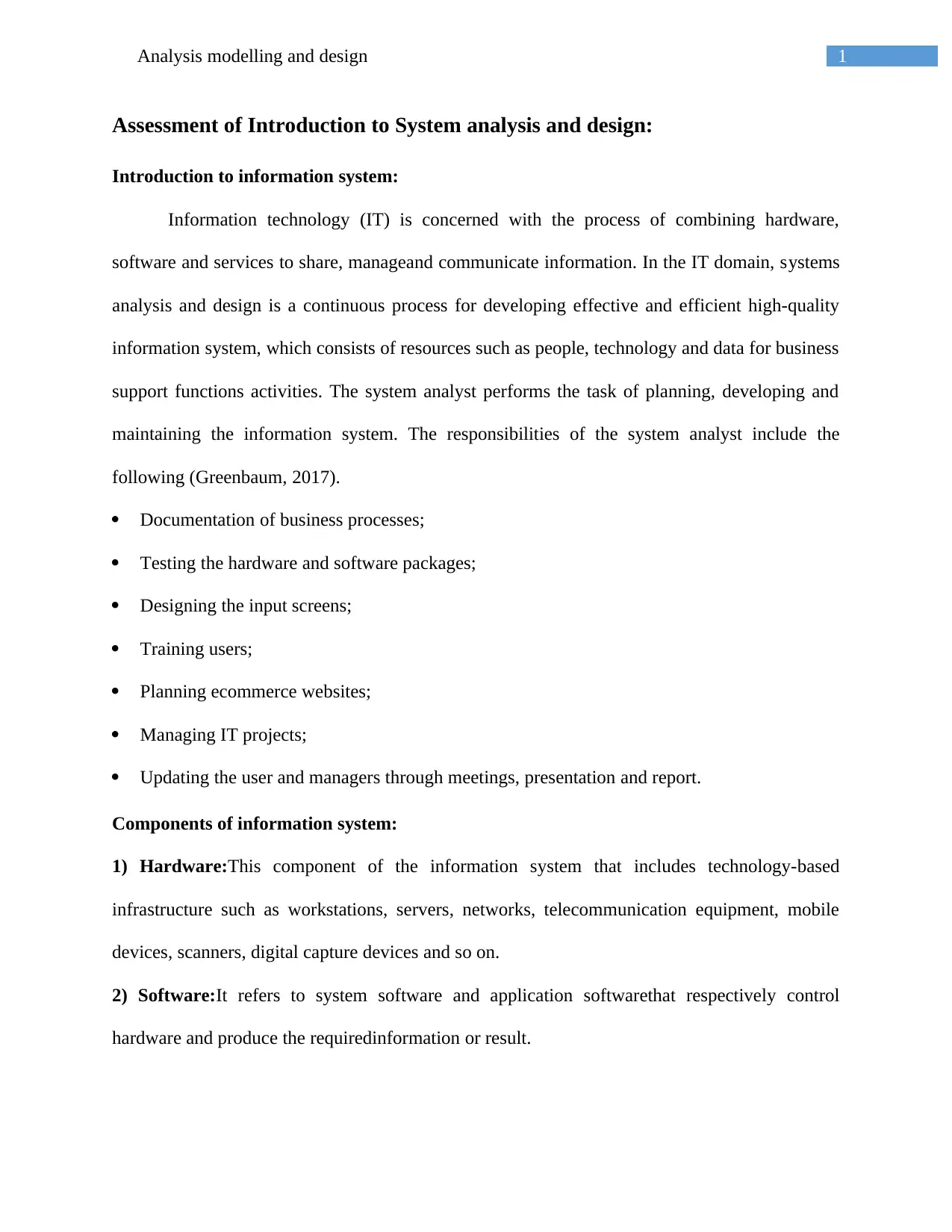
1Analysis modelling and design
Assessment of Introduction to System analysis and design:
Introduction to information system:
Information technology (IT) is concerned with the process of combining hardware,
software and services to share, manageand communicate information. In the IT domain, systems
analysis and design is a continuous process for developing effective and efficient high-quality
information system, which consists of resources such as people, technology and data for business
support functions activities. The system analyst performs the task of planning, developing and
maintaining the information system. The responsibilities of the system analyst include the
following (Greenbaum, 2017).
Documentation of business processes;
Testing the hardware and software packages;
Designing the input screens;
Training users;
Planning ecommerce websites;
Managing IT projects;
Updating the user and managers through meetings, presentation and report.
Components of information system:
1) Hardware:This component of the information system that includes technology-based
infrastructure such as workstations, servers, networks, telecommunication equipment, mobile
devices, scanners, digital capture devices and so on.
2) Software:It refers to system software and application softwarethat respectively control
hardware and produce the requiredinformation or result.
Assessment of Introduction to System analysis and design:
Introduction to information system:
Information technology (IT) is concerned with the process of combining hardware,
software and services to share, manageand communicate information. In the IT domain, systems
analysis and design is a continuous process for developing effective and efficient high-quality
information system, which consists of resources such as people, technology and data for business
support functions activities. The system analyst performs the task of planning, developing and
maintaining the information system. The responsibilities of the system analyst include the
following (Greenbaum, 2017).
Documentation of business processes;
Testing the hardware and software packages;
Designing the input screens;
Training users;
Planning ecommerce websites;
Managing IT projects;
Updating the user and managers through meetings, presentation and report.
Components of information system:
1) Hardware:This component of the information system that includes technology-based
infrastructure such as workstations, servers, networks, telecommunication equipment, mobile
devices, scanners, digital capture devices and so on.
2) Software:It refers to system software and application softwarethat respectively control
hardware and produce the requiredinformation or result.
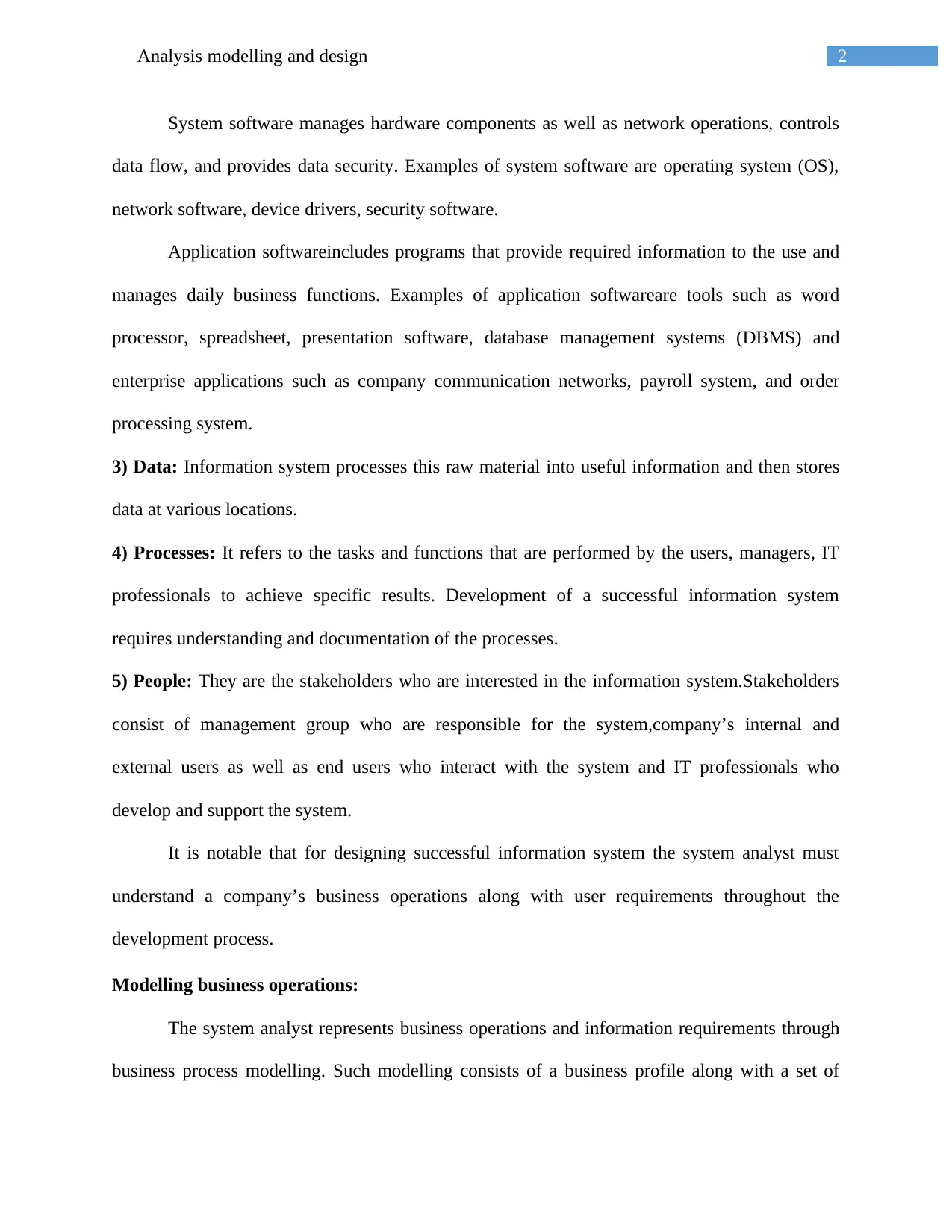
2Analysis modelling and design
System software manages hardware components as well as network operations, controls
data flow, and provides data security. Examples of system software are operating system (OS),
network software, device drivers, security software.
Application softwareincludes programs that provide required information to the use and
manages daily business functions. Examples of application softwareare tools such as word
processor, spreadsheet, presentation software, database management systems (DBMS) and
enterprise applications such as company communication networks, payroll system, and order
processing system.
3) Data: Information system processes this raw material into useful information and then stores
data at various locations.
4) Processes: It refers to the tasks and functions that are performed by the users, managers, IT
professionals to achieve specific results. Development of a successful information system
requires understanding and documentation of the processes.
5) People: They are the stakeholders who are interested in the information system.Stakeholders
consist of management group who are responsible for the system,company’s internal and
external users as well as end users who interact with the system and IT professionals who
develop and support the system.
It is notable that for designing successful information system the system analyst must
understand a company’s business operations along with user requirements throughout the
development process.
Modelling business operations:
The system analyst represents business operations and information requirements through
business process modelling. Such modelling consists of a business profile along with a set of
System software manages hardware components as well as network operations, controls
data flow, and provides data security. Examples of system software are operating system (OS),
network software, device drivers, security software.
Application softwareincludes programs that provide required information to the use and
manages daily business functions. Examples of application softwareare tools such as word
processor, spreadsheet, presentation software, database management systems (DBMS) and
enterprise applications such as company communication networks, payroll system, and order
processing system.
3) Data: Information system processes this raw material into useful information and then stores
data at various locations.
4) Processes: It refers to the tasks and functions that are performed by the users, managers, IT
professionals to achieve specific results. Development of a successful information system
requires understanding and documentation of the processes.
5) People: They are the stakeholders who are interested in the information system.Stakeholders
consist of management group who are responsible for the system,company’s internal and
external users as well as end users who interact with the system and IT professionals who
develop and support the system.
It is notable that for designing successful information system the system analyst must
understand a company’s business operations along with user requirements throughout the
development process.
Modelling business operations:
The system analyst represents business operations and information requirements through
business process modelling. Such modelling consists of a business profile along with a set of
⊘ This is a preview!⊘
Do you want full access?
Subscribe today to unlock all pages.

Trusted by 1+ million students worldwide
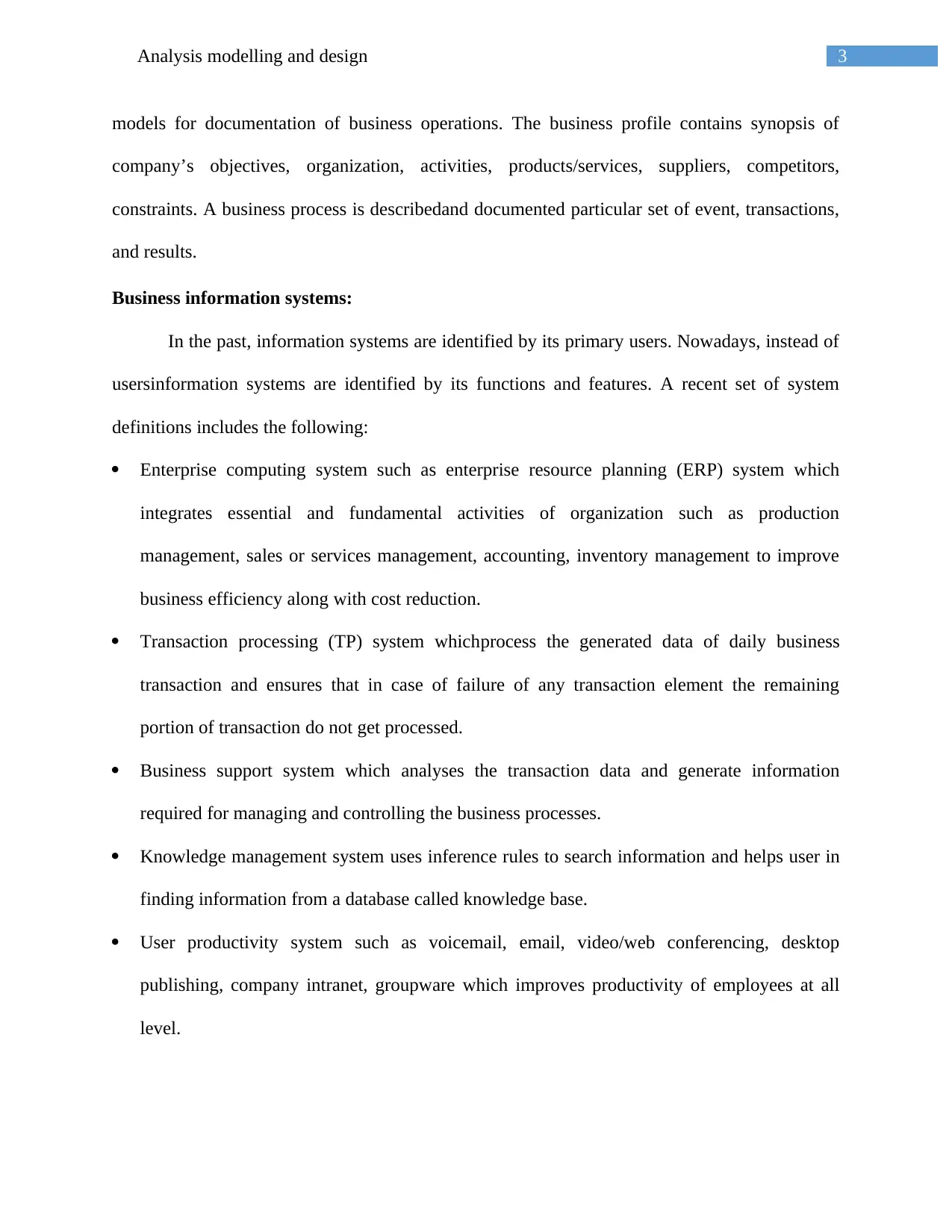
3Analysis modelling and design
models for documentation of business operations. The business profile contains synopsis of
company’s objectives, organization, activities, products/services, suppliers, competitors,
constraints. A business process is describedand documented particular set of event, transactions,
and results.
Business information systems:
In the past, information systems are identified by its primary users. Nowadays, instead of
usersinformation systems are identified by its functions and features. A recent set of system
definitions includes the following:
Enterprise computing system such as enterprise resource planning (ERP) system which
integrates essential and fundamental activities of organization such as production
management, sales or services management, accounting, inventory management to improve
business efficiency along with cost reduction.
Transaction processing (TP) system whichprocess the generated data of daily business
transaction and ensures that in case of failure of any transaction element the remaining
portion of transaction do not get processed.
Business support system which analyses the transaction data and generate information
required for managing and controlling the business processes.
Knowledge management system uses inference rules to search information and helps user in
finding information from a database called knowledge base.
User productivity system such as voicemail, email, video/web conferencing, desktop
publishing, company intranet, groupware which improves productivity of employees at all
level.
models for documentation of business operations. The business profile contains synopsis of
company’s objectives, organization, activities, products/services, suppliers, competitors,
constraints. A business process is describedand documented particular set of event, transactions,
and results.
Business information systems:
In the past, information systems are identified by its primary users. Nowadays, instead of
usersinformation systems are identified by its functions and features. A recent set of system
definitions includes the following:
Enterprise computing system such as enterprise resource planning (ERP) system which
integrates essential and fundamental activities of organization such as production
management, sales or services management, accounting, inventory management to improve
business efficiency along with cost reduction.
Transaction processing (TP) system whichprocess the generated data of daily business
transaction and ensures that in case of failure of any transaction element the remaining
portion of transaction do not get processed.
Business support system which analyses the transaction data and generate information
required for managing and controlling the business processes.
Knowledge management system uses inference rules to search information and helps user in
finding information from a database called knowledge base.
User productivity system such as voicemail, email, video/web conferencing, desktop
publishing, company intranet, groupware which improves productivity of employees at all
level.
Paraphrase This Document
Need a fresh take? Get an instant paraphrase of this document with our AI Paraphraser
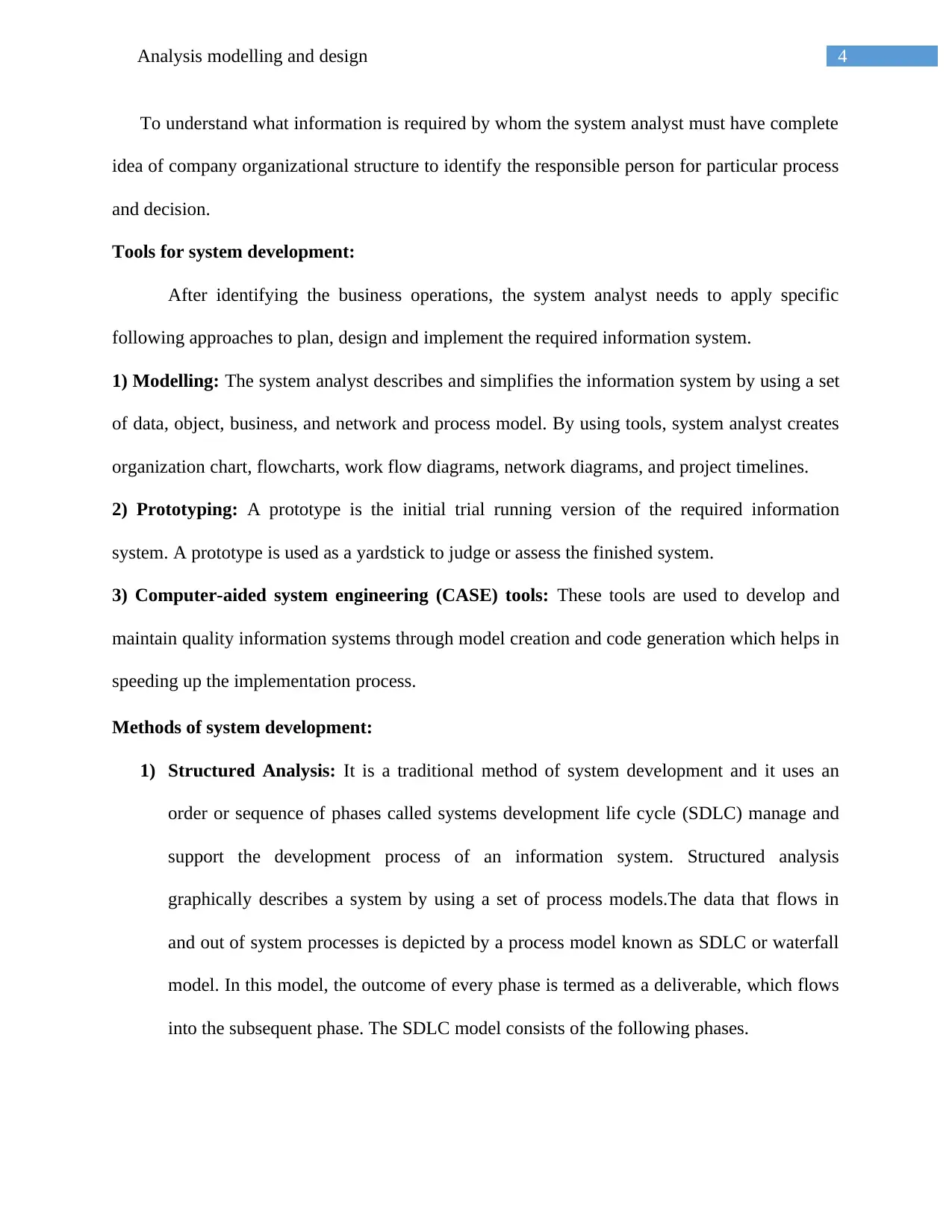
4Analysis modelling and design
To understand what information is required by whom the system analyst must have complete
idea of company organizational structure to identify the responsible person for particular process
and decision.
Tools for system development:
After identifying the business operations, the system analyst needs to apply specific
following approaches to plan, design and implement the required information system.
1) Modelling: The system analyst describes and simplifies the information system by using a set
of data, object, business, and network and process model. By using tools, system analyst creates
organization chart, flowcharts, work flow diagrams, network diagrams, and project timelines.
2) Prototyping: A prototype is the initial trial running version of the required information
system. A prototype is used as a yardstick to judge or assess the finished system.
3) Computer-aided system engineering (CASE) tools: These tools are used to develop and
maintain quality information systems through model creation and code generation which helps in
speeding up the implementation process.
Methods of system development:
1) Structured Analysis: It is a traditional method of system development and it uses an
order or sequence of phases called systems development life cycle (SDLC) manage and
support the development process of an information system. Structured analysis
graphically describes a system by using a set of process models.The data that flows in
and out of system processes is depicted by a process model known as SDLC or waterfall
model. In this model, the outcome of every phase is termed as a deliverable, which flows
into the subsequent phase. The SDLC model consists of the following phases.
To understand what information is required by whom the system analyst must have complete
idea of company organizational structure to identify the responsible person for particular process
and decision.
Tools for system development:
After identifying the business operations, the system analyst needs to apply specific
following approaches to plan, design and implement the required information system.
1) Modelling: The system analyst describes and simplifies the information system by using a set
of data, object, business, and network and process model. By using tools, system analyst creates
organization chart, flowcharts, work flow diagrams, network diagrams, and project timelines.
2) Prototyping: A prototype is the initial trial running version of the required information
system. A prototype is used as a yardstick to judge or assess the finished system.
3) Computer-aided system engineering (CASE) tools: These tools are used to develop and
maintain quality information systems through model creation and code generation which helps in
speeding up the implementation process.
Methods of system development:
1) Structured Analysis: It is a traditional method of system development and it uses an
order or sequence of phases called systems development life cycle (SDLC) manage and
support the development process of an information system. Structured analysis
graphically describes a system by using a set of process models.The data that flows in
and out of system processes is depicted by a process model known as SDLC or waterfall
model. In this model, the outcome of every phase is termed as a deliverable, which flows
into the subsequent phase. The SDLC model consists of the following phases.
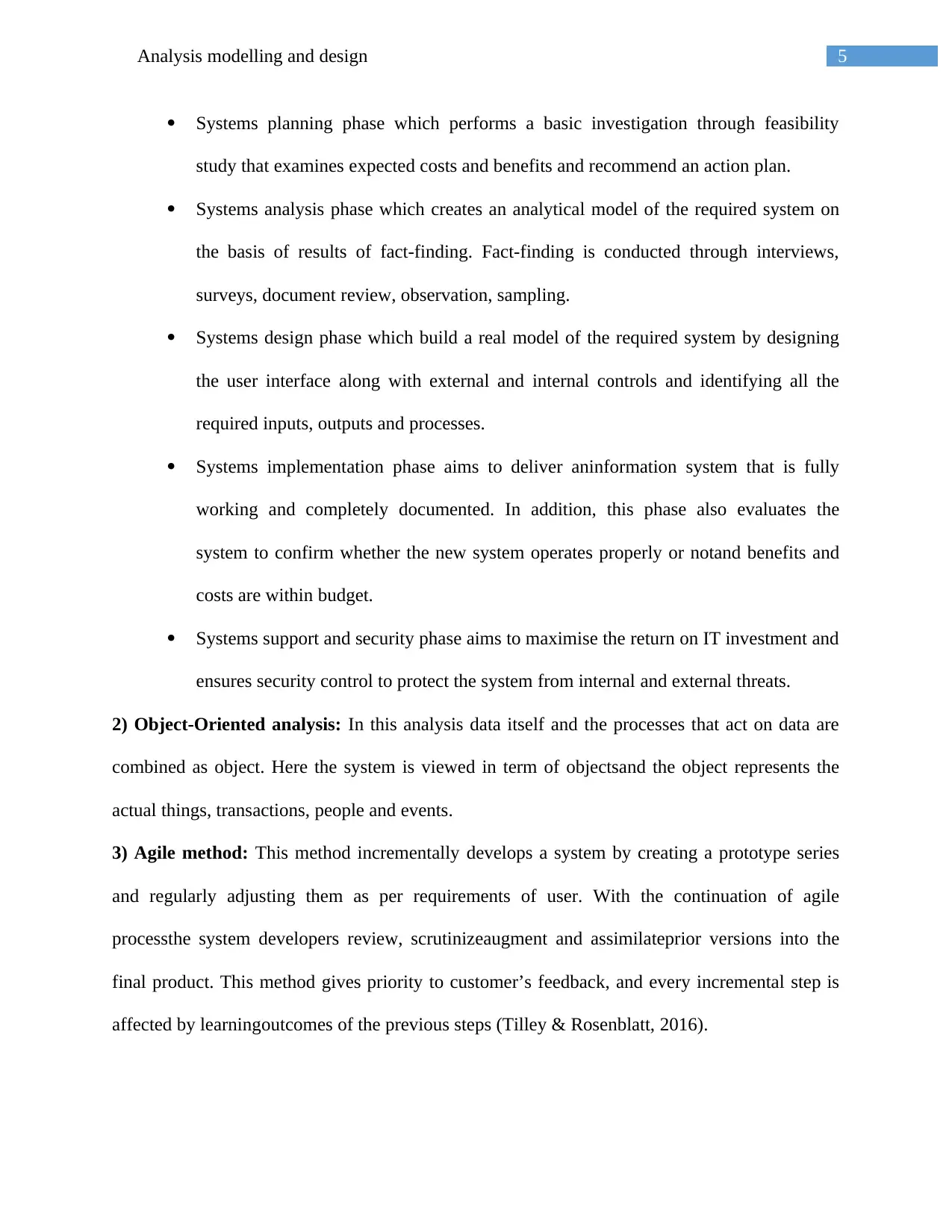
5Analysis modelling and design
Systems planning phase which performs a basic investigation through feasibility
study that examines expected costs and benefits and recommend an action plan.
Systems analysis phase which creates an analytical model of the required system on
the basis of results of fact-finding. Fact-finding is conducted through interviews,
surveys, document review, observation, sampling.
Systems design phase which build a real model of the required system by designing
the user interface along with external and internal controls and identifying all the
required inputs, outputs and processes.
Systems implementation phase aims to deliver aninformation system that is fully
working and completely documented. In addition, this phase also evaluates the
system to confirm whether the new system operates properly or notand benefits and
costs are within budget.
Systems support and security phase aims to maximise the return on IT investment and
ensures security control to protect the system from internal and external threats.
2) Object-Oriented analysis: In this analysis data itself and the processes that act on data are
combined as object. Here the system is viewed in term of objectsand the object represents the
actual things, transactions, people and events.
3) Agile method: This method incrementally develops a system by creating a prototype series
and regularly adjusting them as per requirements of user. With the continuation of agile
processthe system developers review, scrutinizeaugment and assimilateprior versions into the
final product. This method gives priority to customer’s feedback, and every incremental step is
affected by learningoutcomes of the previous steps (Tilley & Rosenblatt, 2016).
Systems planning phase which performs a basic investigation through feasibility
study that examines expected costs and benefits and recommend an action plan.
Systems analysis phase which creates an analytical model of the required system on
the basis of results of fact-finding. Fact-finding is conducted through interviews,
surveys, document review, observation, sampling.
Systems design phase which build a real model of the required system by designing
the user interface along with external and internal controls and identifying all the
required inputs, outputs and processes.
Systems implementation phase aims to deliver aninformation system that is fully
working and completely documented. In addition, this phase also evaluates the
system to confirm whether the new system operates properly or notand benefits and
costs are within budget.
Systems support and security phase aims to maximise the return on IT investment and
ensures security control to protect the system from internal and external threats.
2) Object-Oriented analysis: In this analysis data itself and the processes that act on data are
combined as object. Here the system is viewed in term of objectsand the object represents the
actual things, transactions, people and events.
3) Agile method: This method incrementally develops a system by creating a prototype series
and regularly adjusting them as per requirements of user. With the continuation of agile
processthe system developers review, scrutinizeaugment and assimilateprior versions into the
final product. This method gives priority to customer’s feedback, and every incremental step is
affected by learningoutcomes of the previous steps (Tilley & Rosenblatt, 2016).
⊘ This is a preview!⊘
Do you want full access?
Subscribe today to unlock all pages.

Trusted by 1+ million students worldwide

6Analysis modelling and design
References:
Greenbaum, J. (2017). A design of one’s own: towards participatory design in the United States.
In Participatory Design (pp. 27-37). CRC Press.
Tilley S. & Rosenblatt, H. J. (2016). Systems analysis and design. Cengage Learning.
References:
Greenbaum, J. (2017). A design of one’s own: towards participatory design in the United States.
In Participatory Design (pp. 27-37). CRC Press.
Tilley S. & Rosenblatt, H. J. (2016). Systems analysis and design. Cengage Learning.
1 out of 7
Related Documents
Your All-in-One AI-Powered Toolkit for Academic Success.
+13062052269
info@desklib.com
Available 24*7 on WhatsApp / Email
![[object Object]](/_next/static/media/star-bottom.7253800d.svg)
Unlock your academic potential
Copyright © 2020–2025 A2Z Services. All Rights Reserved. Developed and managed by ZUCOL.





